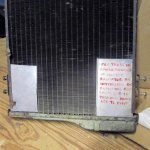1967 BJ8
Need to pull the existing original radiator from the car. Bad leak
On first inspection the unfastening of the bottom radiator hose seems to be a near impossibility. Mirror and light shows a hose clamp around the hose
behind/under a sturdy frame cross member. essentially unreachable with clutsy fingers. Not to mention trying to re-attach upon re-assemble.
It would appear that the radiator cannot be "rocked" far enough foreward to help much because of airway deflecting shields in front of the radiator and fan behind.
I have been searching for a how-to thread to no avail
Anybody have an answer as to how to attack the removal/re-installation of the bottom radiator hose??
Other tips before I start??
Thanks in advance.
Mat
Need to pull the existing original radiator from the car. Bad leak
On first inspection the unfastening of the bottom radiator hose seems to be a near impossibility. Mirror and light shows a hose clamp around the hose
behind/under a sturdy frame cross member. essentially unreachable with clutsy fingers. Not to mention trying to re-attach upon re-assemble.
It would appear that the radiator cannot be "rocked" far enough foreward to help much because of airway deflecting shields in front of the radiator and fan behind.
I have been searching for a how-to thread to no avail
Anybody have an answer as to how to attack the removal/re-installation of the bottom radiator hose??
Other tips before I start??
Thanks in advance.
Mat

 Hi Guest!
Hi Guest!

 smilie in place of the real @
smilie in place of the real @
 Pretty Please - add it to our Events forum(s) and add to the calendar! >>
Pretty Please - add it to our Events forum(s) and add to the calendar! >> 










